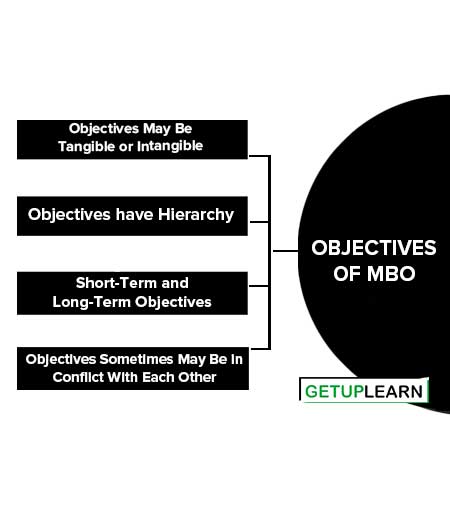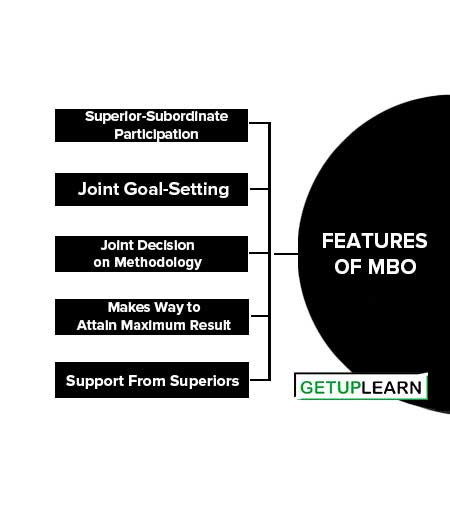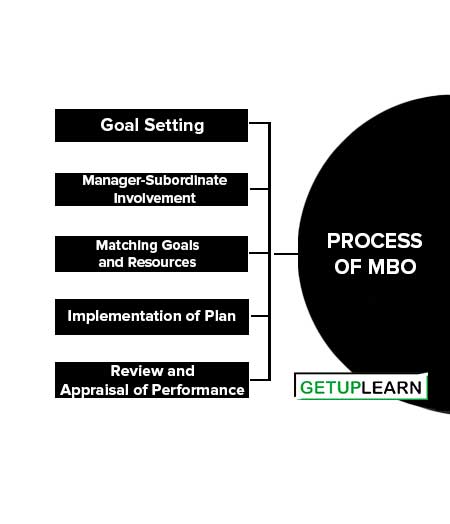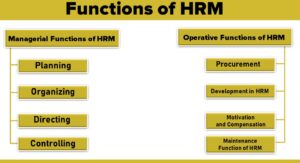Table of Contents
What is Management by Objectives?
Management by objectives (MBO), also known as management by results (MBR), is a process of defining objectives within an organization so that management and employees agree to the objectives and understand what they need to do in the organization in order to achieve them.
MBO is difficult to define. Organizations use it in different ways and for different reasons. In broad terms, it may be stated that MBO is both a philosophy and an approach to management.
It is a process in which superiors and subordinates sit together to identify common objectives and set the goals which are to be achieved by the subordinates, assess the contribution of each individual and integrate individual objectives with those of the organisation so as to make the best use of the available resources of the organisation.
The term “management by objectives” was first popularized by Peter Drucker in his 1954 book The Practice of Management. The essence of MBO is participative goal setting, choosing a course of action and decision-making.
An important part of the MBO is the measurement and comparison of the employee‘s actual performance with the standards set. Ideally, when employees themselves have been involved with the goal setting and choosing the course of action to be followed by them, they are more likely to fulfil their responsibilities.
Definition of MBO
These are some important and easy-to-understand definitions of management by objective from authors:
[su_quote cite=”George S. Ordioruc”]The system of management by objectives can be described as a process whereby the superior and subordinate managers of an organisation jointly identify its common goals, define each individual’s major areas of responsibility in terms of results expected of him, and use these measures as guides for operating the unit and assessing the contribution of each of its members.[/su_quote]
[su_quote cite=”Koontz and Weihrich”]Management by objectives is a comprehensive managerial system that integrates many key managerial activities in a systematic manner and that is consciously directed toward the effective and efficient achievement of organisational and individual objectives.[/su_quote]
[su_quote cite=”S.K. Chakravarty”]MBO is a result-centred, non-specialist, operational managerial process for the effective utilisation of material, physical, and human resources of the organisation by integrating the individual with the organisation and organisation with the environment.[/su_quote]
[su_quote cite=”Terry and Franklin”]A managerial objective is the intended goal that prescribes definite scope and suggests a direction to the planning efforts of a manager.” This definition states four aspects of management by objectives i.e. goal, scope, definiteness, and direction. From a managerial point of view, the target to be achieved should be identified and clear. The scope of the goals should be stated in the prescribed boundaries. The goal should also state definiteness, a vague goal will create more confusion and has no managerial value.[/su_quote]
[su_quote cite=”Pros Reddin”]MBO is the establishment of effective areas and effectiveness standards for management positions and produces a conversion of all these into measurable time-sound objectives linked vertically, and horizontally with future planning.[/su_quote]
[su_quote cite=”John Humble”]MBO is “a dynamic system which seeks to integrate the company’s needs to clarify and achieve its profits and growth goals with the manager’s need to contribute and develop himself. It is a demanding and rewarding style of managing a business.[/su_quote]
Features of MBO
These are the features of MBO explained below:
- Superior-Subordinate Participation
- Joint Goal-Setting
- Joint Decision on Methodology
- Makes Way to Attain Maximum Result
- Support From Superiors
Superior-Subordinate Participation
MBO requires the superior and the subordinate to recognize that the development of objectives is a joint project/activity. They must jointly agree and write out their duties and areas of responsibility in their respective jobs.
Joint Goal-Setting
MBO emphasizes joint goal-setting that is tangible, verifiable and measurable. The subordinate in consultation with his superior sets his own short-term goals. However, it is examined both by the superior and the subordinate that goals are realistic and attainable. In brief, the goals are to be decided jointly through the participation of all.
Joint Decision on Methodology
MBO focuses special attention on what must be accomplished (goals) rather than how it is to be accomplished (methods). The superior and the subordinate mutually devise a methodology to be followed in the attainment of objectives. They also mutually set standards and establish norms for evaluating performance.
Makes Way to Attain Maximum Result
MBO is a systematic and rational technique that allows management to attain maximum results from available resources by focusing on attainable goals. It permits a lot of freedom to subordinate to make creative decisions by him. This motivates subordinates and ensures good performance from them.
Support From Superiors
When the subordinate makes efforts to achieve his goals, the superior’s helping hand is always available. The superior acts as a coach and provides his valuable advice and guidance to the subordinate. This is how MBO facilitates effective communication between superiors and subordinates for achieving the objectives/targets set.
Objectives of MBO
Objectives are the endpoints of management action. They provide meaning to the existence of an organisation. Objectives are the specific targets to be achieved by an organisation. Therefore, the objectives. They are the endpoints towards which all management activities like organising, staffing, directing and controlling are directed.
In other words, only after defining the basic objectives for which an organisation exists, can the manager determine the kind of organisation, the type of personnel and their skills, the kind of motivation and direction and the nature of control techniques which may be employed to achieve the ends.
These are the objectives of MBO given below:
- Objectives May Be Tangible or Intangible
- Objectives have Hierarchy
- Short-Term and Long-Term Objectives
- Objectives Sometimes May Be in Conflict With Each Other

Objectives May Be Tangible or Intangible
That certain objectives may be expressed in quantitative terms. For example, in the areas of market standing, productivity and physical and financial resources quantification are possible. On the other hand, workers’ morale, social responsibility, etc. cannot be exactly quantified.
However, objectives in the latter category may be expressed in qualitative terms. Thus, quantitative objectives are gauged by ‘how much’ while qualitative objectives are by ‘how well’. Accordingly, objectives may also be classified under ‘quantitative’ and ‘qualitative’ objectives.
Objectives have Hierarchy
in that objectives that have a wider scope and are relevant for the whole organisation are known as enterprise objectives. These objectives are split into unit-level or departmental objectives. Thus, objectives at all levels in the organisation are interrelated and form a network.
Short-Term and Long-Term Objectives
Short-term objectives are those which are sought to be achieved by the organisation in the immediate future, while long-term objectives are those which are aimed to be achieved over a long period, say five to ten years or even more. However, both are not mutually exclusive and rather are interrelated.
Objectives Sometimes May Be in Conflict With Each Other
The goals of the various departments at times may clash, in that, each department considers that its goals are more important. For example, the production goal of low unit cost achieved through mass production may be in conflict with the sales goal of offering high-quality goods. Such conflicts have to be resolved amicably.
Process of MBO
These are the steps included in process of management by objectives:
- Goal Setting
- Manager-Subordinate Involvement
- Matching Goals and Resources
- Implementation of Plan
- Review and Appraisal of Performance
Goal Setting
The first phase in the MBO process is to define the organizational objectives. These are determined by the top management and usually in consultation with other managers. Once these goals are established, they should be made known to all the members. In setting objectives, it is necessary to identify “Key-Result Areas’ (KRA).
Manager-Subordinate Involvement
After the organizational goals are defined, the subordinates work with the managers to determine their individual goals. In this way, everyone gets involved in the goal setting.
Matching Goals and Resources
Management must ensure that the subordinates are provided with the necessary tools and materials to achieve these goals. Allocation of resources should also be done in consultation with the subordinates.
Implementation of Plan
After objectives are established and resources are allocated, the subordinates can implement the plan. If any guidance or clarification is required, they can contact their superiors.
Review and Appraisal of Performance
This step involves a periodic review of progress between the manager and the subordinates. Such reviews would determine if the progress is satisfactory or if the subordinate is facing some problems. Performance appraisal at these reviews should be conducted, based on fair and measurable standards.
Advantages of MBO
These are the advantages of management by objectives:
- Develops Result-Oriented Philosophy
- Formulation of Dearer Goals
- Facilitates Objective Appraisal
- Raises Employee Morale
- Facilitates Effective Planning
- Acts as Motivational Force
- Facilitates Effective Control
- Facilitates Personal Leadership

Develops Result-Oriented Philosophy
MBO is a result-oriented philosophy. It does not favour management by crisis. Managers are expected to develop specific individual and group goals, develop appropriate action plans, properly allocate resources and establish control standards. It provides opportunities and motivation to staff to develop and make a positive contribution to achieving the goals of an Organisation.
Formulation of Dearer Goals
Goal-setting is typically an annual feature. MBO produces goals that identify desired/expected results. Goals are made verifiable and measurable which encourages a high level of performance. They highlight problem areas and are limited in number.
The meeting is of minds between the superior and the subordinates. Participation encourages commitment. This facilitates the rapid progress of an Organisation. In brief, the formulation of realistic objectives is me benefit of MBO.
Facilitates Objective Appraisal
NIBO provides a basis for evaluating a person’s performance since goals are jointly set by superiors and subordinates. The individual is given adequate freedom to appraise his own activities. Individuals are trained to exercise discipline and self-control.
Management by self-control replaces management by domination in the MBO process. The appraisal becomes more objective and impartial.
Raises Employee Morale
Participative decision-making and two-way communication encourage the subordinate to communicate freely and honestly. Participation, clearer goals and improved communication will go a long way in improving the morale of employees.
Facilitates Effective Planning
MBO programmes sharpen the planning process in an Organisation. It compels managers to think of planning by results. Developing action plans, providing resources for goal attainment and discussing and removing obstacles demand careful planning. In brief, MBO provides better management and better results.
Acts as Motivational Force
MBO gives an individual or group, the opportunity to use imagination and creativity to accomplish the mission. Managers devote time to planning results. Both appraiser and appraise are committed to the same objective. Since MBO aims at providing clear targets and their order of priority, employees are motivated.
Facilitates Effective Control
Continuous monitoring is an essential feature of MBO. This is useful for achieving better results. Actual performance can be measured against the standards laid down for measurement of performance and deviations are corrected in time. A clear set of verifiable goals provides an outstanding guarantee for exercising better control.
Facilitates Personal Leadership
MBO helps individual managers to develop personal leadership and skills useful for the efficient management of activities of a business unit. Such a manager enjoys better chances to climb the promotional ladder than a non-MBO type.
Limitations of MBO
These are the limitations of management by objectives:
- Time-Consuming
- Reward-Punishment Approach
- Increases Paper-Work
- Creates Organizational Problems
- Develops Conflicting Objectives
- Problem of Coordination
- Lacks Durability
- Problems Related to Goal-Setting
- Lack of Appreciation
Time-Consuming
MBO is a time-consuming process. Objectives, at all levels of the Organisation, are set carefully after considering pros and cons which consumes a lot of time. The superiors are required to hold frequent meetings in order to acquaint subordinates with the new system. The formal, periodic progress and final review sessions also consume time.
Reward-Punishment Approach
MBO is a pressure-oriented programme. It is based on reward-punishment psychology. It tries to indiscriminately force improvement on all employees. At times, it may penalize the people whose performance remains below the goal. This puts mental pressure on staff. The reward is provided only for superior performance.
Increases Paper-Work
MBO programmes introduce an ocean of paperwork such as training manuals, newsletters, instruction booklets, questionnaires, performance data and report into the Organisation. Managers need information feedback, in order to know what is exactly going on in the Organisation.
The employees are expected to fill in a number of forms thus increasing the paperwork. In the words of Howell, “MBO effectiveness is inversely related to the number of MBO forms.
Creates Organizational Problems
MBO is far from a panacea for all organizational problems. Often MBO creates more problems than it can solve. An incident of tug-of-war is not uncommon. The subordinates try to set the lowest possible targets and superiors the highest.
When objectives cannot be restricted in number, it leads to obscure priorities and creates a sense of fear among subordinates. Added to this, the programme is used as a ‘whip’ to control employee performance.
Develops Conflicting Objectives
Sometimes, an individual’s goal may come in conflict with those of another e.g., the marketing manager’s goal for high sales turnover may find no support from the production manager’s goal for production with the least cost. Under such circumstances, individuals follow paths that are best in their own interest but which are detrimental to the company.
Problem of Coordination
Considerable difficulties may be encountered while coordinating the objectives of the Organisation with those of the individual and the department. Managers may face problems in measuring objectives when the objectives are not clear and realistic.
Lacks Durability
The first few go-arounds of MBO are motivating. Later it tends to become an old hat. The marginal benefits often decrease with each cycle. Moreover, the programme is deceptively simple. New opportunities are lost because individuals adhere rigidly to established goals.
MBO can function successfully provided measurable objectives are jointly set and it is agreed upon by all. Problems arise when:
- Verifiable goals are difficult to set.
- Goals are inflexible and rigid.
- Goals tend to take precedence over the people who use them.
- Greater emphasis on quantifiable and easily measurable results instead of important results.
- Over-emphasis on short-term goals at the cost of long-term goals.
Lack of Appreciation
Lack of appreciation of MBO is observed at different levels of the Organization. This may be due to the failure of the top management to communicate the philosophy of MBO to the entire staff and all departments.
Similarly, managers may not delegate adequately to their subordinates or managers may not motivate their subordinates properly. This creates new difficulties in the execution of the MBO programme.
What is MBO in Management?
MBO is the establishment of effective areas and effectiveness standards for management positions and produces a conversion of all these into measurable time-sound objectives linked vertically, and horizontally with future planning.
What is the Definition of MBO?
“Management by objectives is a comprehensive managerial system that integrates many key managerial activities in a systematic manner and that is consciously directed toward the effective and efficient achievement of organisational and individual objectives.” By Koontz and Weihrich
What are the features of MBO?
The following are the features of MBO:
1. Superior-Subordinate Participation
2. Joint Goal-Setting
3. Joint Decision on Methodology
4. Makes Way to Attain Maximum Result
5. Support From Superiors.
What are the objectives of MBO?
The following are the objectives of MBO:
1. Objectives May Be Tangible or Intangible
2. Objectives have a Hierarchy
3. Short-Term and Long-Term Objectives
4. Objectives Sometimes May Be in Conflict With Each Other.
What is the process of MBO?
The following are the steps of the process of MBO:
5.1 Goal Setting
2. Manager-Subordinate Involvement
3. Matching Goals and Resources
4. Implementation of Plan
5. Review and Appraisal of Performance.
What are the advantages of MBO?
The following are the advantages of MBO:
1. Develops Result-Oriented Philosophy
2. Formulation of Dearer Goals
3. Facilitates Objective Appraisal
4. Raises Employee Morale
5. Facilitates Effective Planning
6. Acts as Motivational Force
7. Facilitates Effective Control
8. Facilitates Personal Leadership.
What are the limitations of MBO?
The following are the limitations of MBO:
1. Time-Consuming
2. Reward-Punishment Approach
3. Increases Paper-Work
4. Creates Organizational Problems
5. Develops Conflicting Objectives
6. Problem of Coordination
7. Lacks Durability
8. Problems Related to Goal-Setting
9. Lack of Appreciation.


















